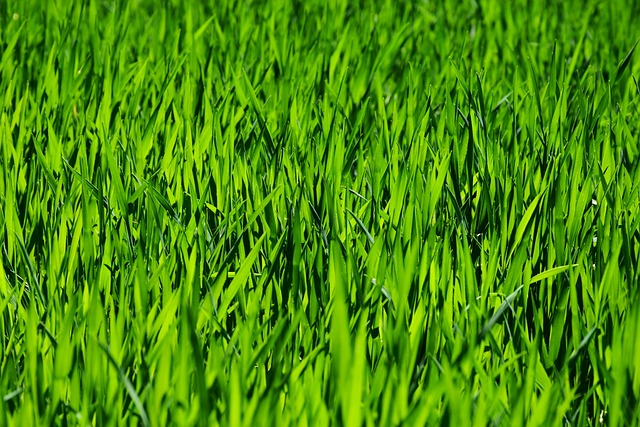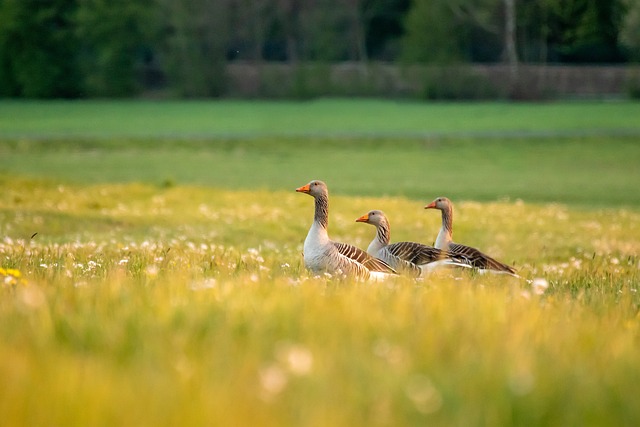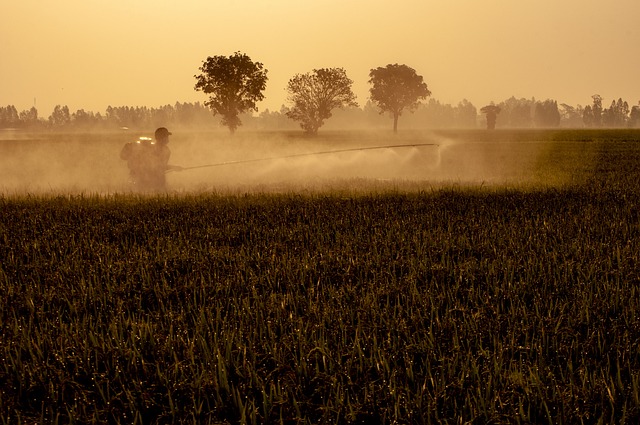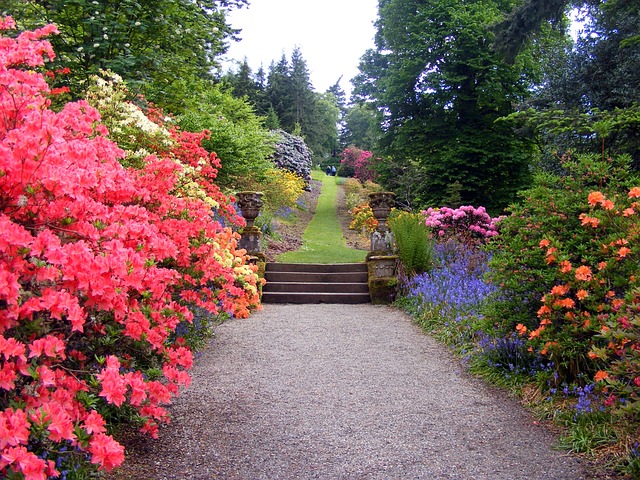Lawn Care and Landscaping are pivotal for maintaining a lush and healthy lawn. A robust fertilization program with timed applications of nitrogen, phosphorus, and potassium is crucial for grass health and disease resistance. Soil composition and pH levels should be understood to select the right fertilizer for optimal results. The best times for fertilization are early spring and late fall when soil temperatures are favorable. A consistent fertilization routine during the growing season, along with incorporating organic matter into the soil, ensures sustained nutrient supply and helps defend against weeds and pests. Strategic weed control, including pre-emergent and post-emergent herbicides tailored to specific weed types, is essential. Mowing at optimal heights for your grass type, consistent irrigation, and aeration also play significant roles in maintaining soil health and deterring weeds. Integrating these practices with informed landscaping decisions enhances the lawn's appearance while promoting a balanced and sustainable ecosystem. The use of native species and natural barriers further supports this balance, emphasizing the importance of a comprehensive approach to lawn care and landscaping for both aesthetic and ecological benefits.
lawn care and landscaping play pivotal roles in nurturing a thriving lawn, effectively managing fertilization and weed control are key. This article delves into the essentials of lawn fertilization to promote lush growth, explores strategic methods for weed eradication, and integrates these practices with landscape design for an aesthetically pleasing and healthy outdoor space. By understanding the nuances of soil health and weed dynamics, homeowners can achieve a vibrant lawn that complements their landscaping efforts, ensuring a harmonious environment throughout the seasons.
- Understanding the Basics of Lawn Fertilization for Vibrant Growth
- Strategic Weed Control: Methods and Best Practices for a Weed-Free Lawn
- Integrating Lawn Care and Landscaping Techniques for a Harmonious Environment
Understanding the Basics of Lawn Fertilization for Vibrant Growth

Lawn care and landscaping professionals emphasize that a well-fertilized lawn is the cornerstone of vibrant growth and aesthetic appeal. Fertilization is a critical component of lawn maintenance, as it provides the necessary nutrients to support grass health and resilience. The process begins with understanding your soil’s composition and pH level to select a fertilizer that complements these conditions. Nitrogen-rich fertilizers, for instance, promote leaf growth, ensuring a lush, green carpet. Phosphorus supports root development, which is crucial for a strong and resilient lawn structure. Additionally, potassium contributes to overall plant health and disease resistance.
Timing is pivotal in effective lawn fertilization; applications should be scheduled according to regional climate patterns and the specific type of grass present. Early spring and late fall are optimal times for fertilization to prepare the lawn for the growing season ahead. In these periods, the soil temperatures are conducive to nutrient absorption without the risk of excessive growth that could lead to diseases or pests. A consistent fertilization routine, often following a 4-6 week schedule, ensures a steady supply of nutrients throughout the growing season, sustaining the lawn’s vibrant appearance and resilience against weeds and pests. Landscaping experts also recommend incorporating organic matter into the soil, which can improve soil quality over time, further contributing to a healthy and thriving lawn. With a clear understanding of the basics of lawn fertilization, homeowners can achieve a landscape that is both beautiful and resilient against the challenges posed by various environmental factors.
Strategic Weed Control: Methods and Best Practices for a Weed-Free Lawn

Maintaining a lush, green lawn requires diligent lawn care and strategic weed control practices. A well-nourished lawn can outcompete weeds naturally, which is where a thoughtful fertilization regimen comes into play. Fertilizing your lawn with the right nutrients at the appropriate times encourages healthy grass growth, making it more resistant to invasive weeds. For effective weed control, it’s crucial to understand the life cycle of common lawn weeds and apply preventative measures accordingly. Pre-emergent herbicides can be applied to stop weed seeds from germinating, while post-emergent treatments are used on established weeds. It’s important to select the right type of herbicide for the specific weed you’re targeting, as broadleaf and grassy weeds each require tailored approaches.
In addition to chemical control, mechanical and cultural practices also play a significant role in keeping your lawn weed-free. Regular mowing at the correct height for your grass species can shade out weeds, while proper irrigation and aeration help maintain soil health and further reduce weed encroachment. Integrating these methods into a comprehensive lawn care and landscaping plan will not only enhance the aesthetics of your yard but also contribute to its overall resilience against unwanted vegetation. By staying informed on the latest best practices and trends in lawn care, homeowners can effectively manage their lawns for a weed-free, thriving landscape.
Integrating Lawn Care and Landscaping Techniques for a Harmonious Environment

Integrating lawn care and landscaping techniques creates a synergy that promotes a harmonious environment. A well-maintained lawn serves as the foundation of any landscape design, enhancing both the aesthetic appeal and the ecological balance of the outdoor space. Effective lawn care, which includes regular fertilization, aeration, and correct watering practices, lays the groundwork for a thriving turf that can outcompete weeds naturally. By selecting grass varieties and landscaping elements that are well-suited to the local climate and soil conditions, homeowners can minimize the need for chemical interventions and create a more sustainable environment. The choice of plants, shrubs, and trees complements the lawn, providing a diverse habitat that supports beneficial insects and birds, which in turn contributes to natural pest control and weed suppression. This holistic approach not only improves the health of the grass but also ensures that the entire landscape contributes positively to the ecosystem, fostering biodiversity and resilience while maintaining a visually pleasing and functional outdoor space. Landscaping with native species and incorporating natural barriers can further enhance this balance, making it an essential aspect of both lawn care and environmental stewardship.
Effective lawn care and landscaping practices are pivotal in maintaining a lush, healthy lawn. This article has delved into the nuances of fertilization for vibrant growth, explored strategic weed control methods, and integrated these with landscaping techniques to create a harmonious environment. By understanding the basics of lawn fertilization and employing best practices for weed control, homeowners can achieve a lawn that stands out as a testament to diligent care. Implementing these lawn care strategies not only enhances the aesthetic appeal but also fosters soil health and biodiversity, contributing positively to the overall ecosystem. As such, taking a proactive approach to lawn maintenance through thoughtful fertilization and targeted weed management is essential for any landscaping endeavor.
